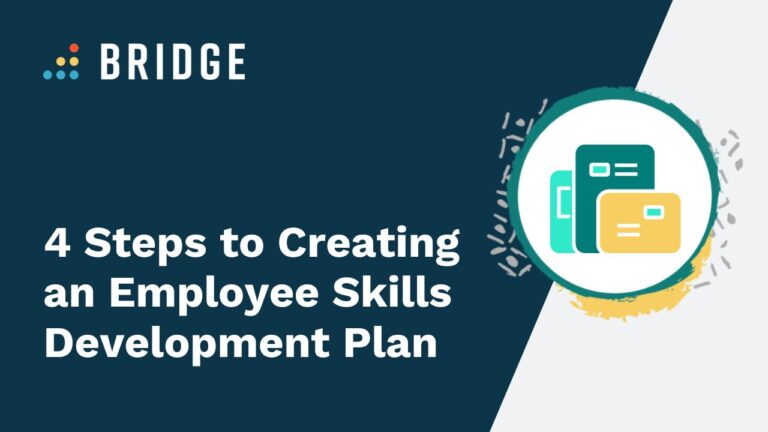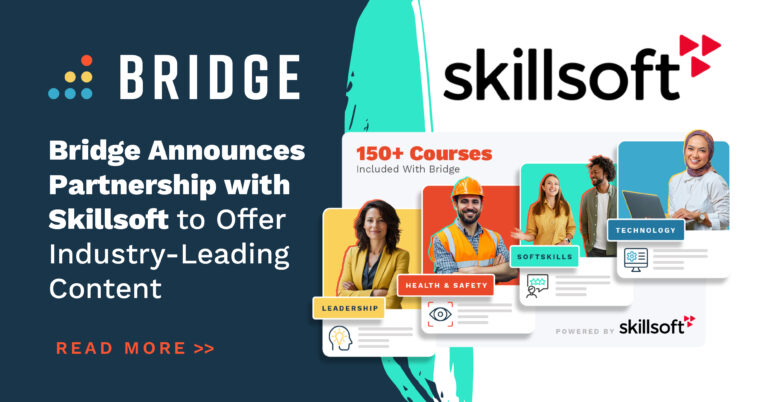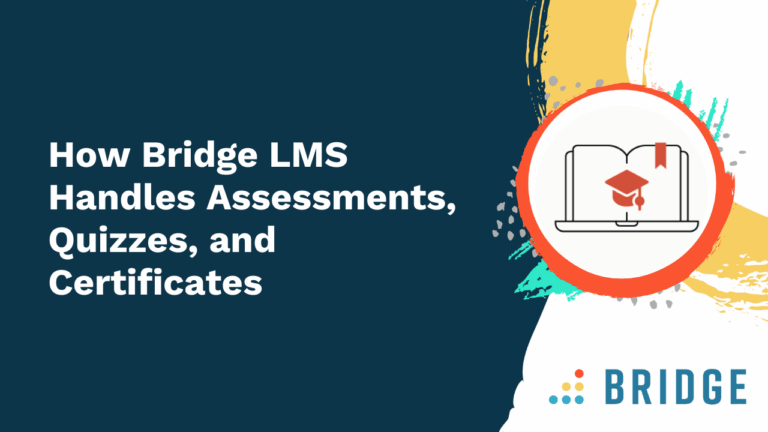Find out how to create and action a skills development plan that meets evolving business demand and connects employees to L&D opportunities that boost their knowledge and competencies.
Meeting future demand means investing in employee training and development. Bridge’s report in partnership with HR Research Institute reveals that for 49% of HR professionals, developing employee skills is one of the most important factors driving workplace learning. What’s more, nearly 50% of respondents anticipate that learning technologies will increase their focus on skills-based learning and development in the future.
Skills power your people, allowing them to turn challenges into solutions and to work in new and flexible ways. This requires an ongoing strategy, so here are four steps to create a framework for employee skills development.
Step One: Define the Skills Your Organization Has and the Skills It Needs
Assessing skills connects goals and priorities with existing competencies, and if skills gaps exist, it allows you to target training.
1) Define Your Business Goals and Priorities
Skills development initiatives should be planned and enacted within the context of your organization and its strategy. And the first step is to identify your current and future objectives.
Start with a broad view of your business before filtering goals down to departments and teams. Have a clear view of future planning and objectives at all levels of your organization.
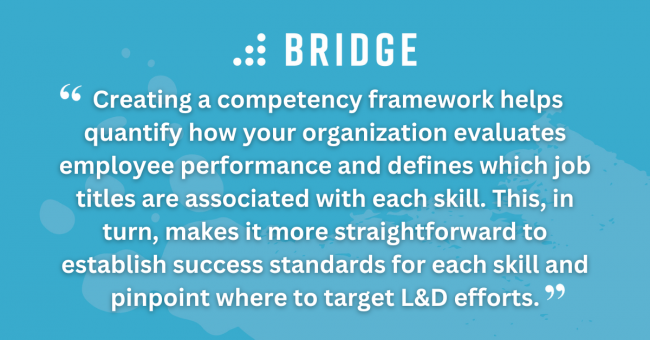
2) Outline Skills Requirements to Meet Those Goals
By creating a detailed skills taxonomy, you build a framework to define and categorize the skills and behaviors your organization needs, the levels of proficiency within those skills, and the required roles to meet goals.
An accurate and efficient way to source and build this framework is with an AI-powered skills platform. Access to internal and external employee datasets can accelerate strategy building with insight into necessary and in-demand skills.
3) Conduct a Skills Assessment
With knowledge of the skills within your organization, it’s important to match them with specific job functions and roles in your business. In doing so, identify who possesses each of the desired skills and define their level of mastery.
Creating a competency framework helps quantify how your organization evaluates employee performance and defines which job titles are associated with each skill. This, in turn, makes it more straightforward to establish success standards and pinpoint where to target L&D efforts.
The methods used to measure employee skills can take a wide variety of forms, including:
- Data from previous performance evaluations and talent reviews
- Skills assessments and 360 feedback
- Test scores and assessments
- Interviews with managers and employees
- Practice-based exercises and activities to estimate skill levels
DISCOVER HOW TO MAP YOUR SKILLS | ‘Skills Mapping 101: How to Visualize Employee Capabilities’
4) Find and Fill Skills Gaps
A skills analysis leads to more informed talent decisions. Typically, addressing skills gaps will result in adjustments to HR processes and learning and development strategies in the form of hiring alongside reskilling and upskilling programs.
While some skills gaps can be addressed through your recruitment efforts, a robust skills framework should also look to strengthen your internal talent. According to recruiting pros polled in LinkedIn’s Future of Recruiting report, the next five years of recruiting will be shaped by:
- Upskilling and reskilling talent (81%)
- Filling roles through internal hires (75%)
Analyze the findings from skills assessments to find existing gaps within your workforce. By visualizing these skills and overlaying them against goals, you can locate opportunities for improvement.
Step Two: Develop a Skills-Based Employee Training Strategy
A view of existing and priority skills can inform learning and development programs that fill gaps and target training in the most beneficial ways. Once you identify skills, you’ll want to plan how to connect people with training.
1) Define the Learning and Development Objectives
While a skills assessment will offer the information needed to revamp training programs, you need clearly defined metrics to track and assess improvements to operational performance, behavior, and the financial impact of skills development efforts.
After determining the skills you need, you should set learning objectives to outline what type of training should occur and what learners should be able to demonstrate as a result. Effective learning objectives should be measurable and based on the business needs and goals previously identified.
With a set of predefined success metrics, you can show the before and after of skills development programs, illustrating their impact and effectiveness.
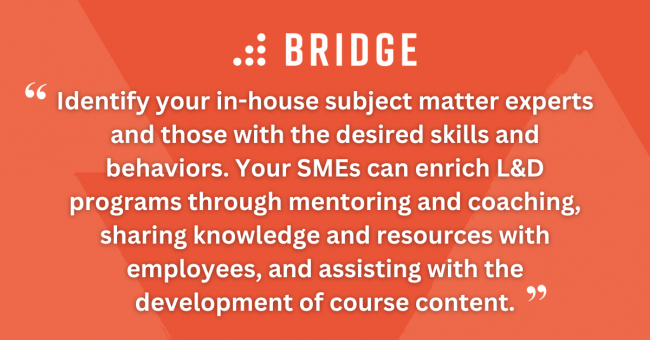
2) Identify Your Subject Matter Experts
Equipping employees with the skills your organization needs to close gaps and plan for the future means fostering closer collaboration and transparency among business departments and functions.
Identify your in-house subject matter experts and those with the desired skills and behaviors. Your SMEs can enrich L&D programs through mentoring and coaching, sharing knowledge and resources with employees, and assisting with the development of course content.
MORE ON MENTORING | ‘Corporate Mentorship: How to Match Mentors With Mentees’
3) Develop a Project Timeline
Create a schedule to track the development and delivery of training. For straightforward training and skills gaps, this could be as simple as a deadline for completion.
For larger or more business-critical development initiatives and those likely to span longer periods, you'll want to devise a more detailed timeline complete with milestones and checkpoints. This way, you plan what people need to learn, at what point, and how you'll check that they're on track.
4) Select a Learning Platform
One of the most important elements to consider when making a skills development plan is the type of platform you need. An effective learning platform will enhance L&D experiences, enable greater personalization, and unlock deeper insight through data.
Review the tech your organization uses to manage skills, L&D, and performance. The best solutions will seamlessly integrate your L&D and HR tools and data, bringing everything together in one place, allowing for greater transparency.
Here’s how a learning management system can support your skills strategy:
- Recommending skills communities, mentors, and relevant L&D opportunities
- Creating, authoring, and categorizing courses
- Enabling scenario-based training and practice simulations
- Gaining visibility into feedback and goal performance
- Facilitating peer and community-based learning
- Integrating an HRIS to create a single source for your people data
FIND AN LMS THAT MEETS YOUR NEEDS | ‘What Is a Learning Management System (LMS), and Why Would You Need One?’
5) Build and Present a Training Budget to Stakeholders
With a plan informing content and technology needs, you'll have a view of the cost and time involved that you can share with stakeholders for approval.
To gain buy-in and support, you need to create a shared purpose and value for learning and development programs that demonstrate the impact.
Leaders must see a short- and long-term vision for skills development programs. Whether it's your middle managers or C-suite execs, present the impact of skills development and the positive impact on business goals, such as minimizing risk and increasing revenue via employee productivity.
TIPS FOR BUILDING A BUDGET | ‘How to Create an L&D Budget You Can Defend to Your CFO’
Step Three: Implement Employee Learning and Development Programs
With the green light from your stakeholders, you're free to design and deliver training and development programs to employees.
1) Create and Curate Content
At this stage, think about the training methods that are most likely to build skills and lead to long-term behavior changes. You'll want to create a targeted and contextual approach that increases employee appetites for learning and ultimately results in organizational change.
Review existing training resources to assess what you have and what's missing. There's no need to start from the ground up—if the content is outdated or locked away in lengthy courses, refreshing materials with your in-house authoring tool or filling any gaps by buying premade content might be an excellent use of your resources.
Collaborate with your experts to create a relevant and user-friendly experience, encouraging their contributions through content creation and knowledge sharing. A library of informal how-to videos and best practices from familiar faces within your organization will immediately be more relevant and engaging to your people.
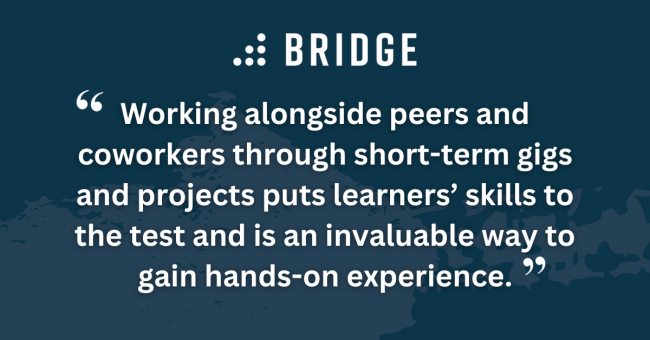
MORE INSIGHTS TO EXPLORE | ‘4 Ways to Create an L&D Experience That Truly Engages Learners’
2) Provide Practical Skills Development Experience
For skills-based learning pathways leading to internal mobility and growth, look beyond linear career planning and integrate skills and knowledge-building opportunities into development pathways.
As Gartner finds, when organizations support habit-building through reinforcement and repetition, the effectiveness of building new skills can increase by up to 44%.
In addition, learning activities must also happen in the flow of work, giving people the space to practice and gain valuable on-the-job experience. Working alongside peers and coworkers through short-term gigs and projects puts their skills to the test and is an invaluable way to gain hands-on experience.
Mentorship and coaching opportunities can further strengthen employee skills development through tailored advice and feedback based on learner performance. This connects people with experienced managers, SMEs, or peers based on their skills and keeps them on track toward achieving their goals.
RELATED READING | ‘3 Ways to Maintain an Effective Corporate Mentoring Program’
3) Keep Training Relevant to Goals
Keep the end-goal in mind when building L&D programs to be sure that each course, program, and assessment adds value. When employee and business goals are closely aligned, and skills development feeds into performance metrics, your people immediately see the value in what they're doing and how it benefits the organization.
Learning pathways should also be designed to meet the diverse interests, needs, and learning styles of your people. Considering your audience and their specific needs and goals will help you deliver relevant and targeted training that leads to long-term behavior changes.
To help people make time for learning and encourage knowledge retention, include a mix of multimodal on-demand resources and interactive elements.
Think about some of the following questions to keep L&D programs relevant:
- What’s the best delivery method for this training?
- What’s the end-goal or purpose of the training?
- Is the training mandatory or optional?
- Does the audience have prior knowledge of the topic?
- How much time does training require?
- How will learners demonstrate skills proficiency?
4) Roll Out Training Programs
No matter how comprehensive or well-planned a skills strategy is, you're unlikely to achieve the desired results if employees aren't fully invested or don't see the value. To get your people on board, clarify how L&D programs and tools benefit them, what they'll learn, and how L&D supports them in their career development and growth.
Start small and test a program on a single group before scaling your approach—this way, you can use their feedback to perfect programs along the way.
BEST PRACTICES FOR SUCCESSFUL IMPLEMENTATION | ‘How to Roll Out New HR Software to Employees: 8 Ways to Make Sure Teams Use It’
Step Four: Continuously Monitor and Improve Training Programs
A skills assessment isn’t a one-time process—it requires ongoing updates and improvements to maintain momentum. Continue to monitor training results after implementation and refine your strategies.
1) Continually Review Quizzes and Checkpoints to Assess Learner Progress
Measure training progress and performance against initial learning objectives using quizzes, assessments, and checkpoints during learning journeys. With this information, you can check how well people begin to cement their understanding of new concepts and develop existing behaviors and competencies over time.
By placing quizzes and assessments at key points during learning and development programs, you'll gain results and scores that can flag any gaps in training or areas where learners require additional support. Ongoing monitoring and reviewing makes it possible to proactively fill these gaps and tweak content as needed.
2) Ensure Managers and Employees Engage in One-on-Ones
It's best practice for managers and employees to set regular time aside each week to discuss performance, address priorities, and identify areas where employees could benefit from additional support. These conversations will gently nudge people toward their goals and help them overcome any barriers.
Engaging in regular conversations throughout the performance cycle and tracking them with an agenda can also lead to more informed decisions about talent. This feeds into an inventory of feedback, recognition, and employee achievements, all of which can inform career and performance conversations.
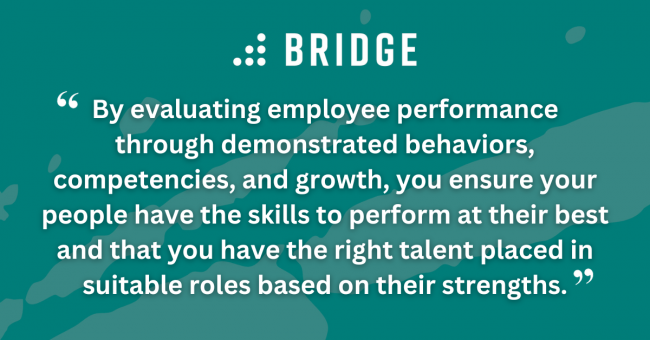
3) Use Performance Data to Assess Skills
Use readily available data to enhance training and talent management practices. With a learning platform, you're able to use skills as the basis to track and make decisions about the workforce based on output and competencies.
This is a sentiment shared by employees and leaders alike, and according to a report compiled by Deloitte, 79% of employees consider demonstrated skills and competencies as the most important criteria for organizations when assessing and rewarding performance. Likewise, 67% of HR and business leaders agree that it's a valuable source of information on the workforce.
By evaluating employee performance through demonstrated behaviors, competencies, and growth, you ensure your people have the skills to perform at their best and that you have your talent placed in suitable roles based on their strengths.
MORE WAYS TO MAKE YOUR HR DATA WORK FOR YOU | ‘The Power of People Analytics: How to Turn People Data Into Business Results’
4) Meet With Content Stakeholders and Managers
When it comes to cross-functional collaboration, regular communication is key, as execs and decision-makers can offer timely updates about plans and actions that might inform the direction of training programs. Share the results of upskilling and reskilling initiatives in the form of easy-to-read metrics and reports that clearly show how skills development feeds into business goals.
Additionally, your people managers and leaders should continue to be part of conversations to share feedback about where employees' priorities lie. As those closest to learners, they're well placed to offer suggestions about what resources people can use to do their jobs well and provide learning formats that resonate.
ADDITIONAL INSIGHTS | ‘6 Reasons Why Employee Development Programs Are So Important—And How to Execute Them Well’
5) Use Employee Engagement Surveys to Gather Learner Feedback
If you want to know how employees feel about the training and development opportunities available, simply ask them! Post-training and employee engagement surveys are a convenient way to measure learner sentiment and satisfaction over time and gather opinions about their likes and dislikes.
Use feedback to adjust and improve skills programs, and be sure to share any changes you intend to make and the reasons behind them. Follow-up pulse surveys at regular intervals throughout the year will show you the progress of your efforts and create a story with data you can share with stakeholders.
EXPLORE MORE SKILLS-BASED PRACTICES TO INCREASE ENGAGEMENT | ‘4 Ways to Fuel Employee Engagement With Skills Development’
Supercharge Your Skills Development With Bridge
Unleash the full potential of your training plans with a combination of Bridge's learning and performance management tools, paired with the AI-enhanced power of Bridge Skills Plus.
Request a demo to see how Bridge can revolutionize your L&D strategies and empower growth by finding emerging skills gaps, connecting people with personalized training opportunities, and facilitating mentoring and coaching via skills communities.
